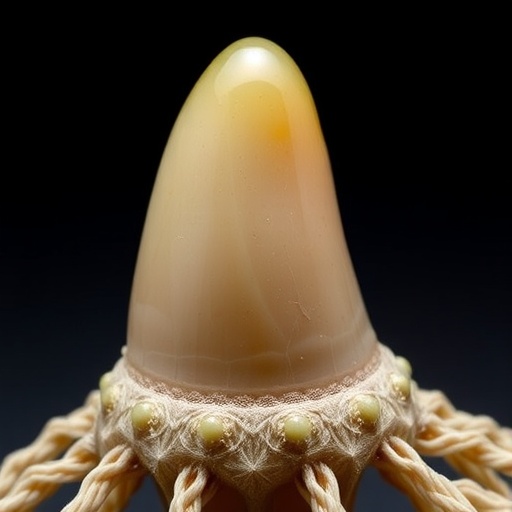
Unlocking Nature’s Nanotechnology: How Chiton Teeth Inspire Next-Generation Advanced Materials
In a groundbreaking study published in Science, researchers from the University of California, Irvine, in collaboration with Japan’s Okayama and Toho universities, have unraveled the sophisticated biological mechanisms that enable chitons—marine mollusks inhabiting intertidal zones—to develop exceptionally hard, wear-resistant, and magnetic teeth. This discovery not only deepens our understanding of biomineralization and iron metabolism at the cellular level but also paves the way for novel advancements in materials science, potentially revolutionizing the synthesis and manufacturing of industrially relevant composites.
Chitons, small mollusks distinct for their ability to graze algae off rocky coastal surfaces, possess a unique dental structure composed chiefly of magnetite nanorods reinforced with organic matrices. Unlike conventional engineered materials that require energy-intensive, high-temperature processes, chiton teeth are formed at ambient temperatures through highly orchestrated biological processes. The research team focused on a chiton-specific protein known as Radular Teeth Matrix Protein 1 (RTMP1), elucidating how it directs the controlled deposition of iron oxide within tooth structures via an intricate cellular transport network.
.adsslot_OY2GDokcTZ{width:728px !important;height:90px !important;}
@media(max-width:1199px){ .adsslot_OY2GDokcTZ{width:468px !important;height:60px !important;}
}
@media(max-width:767px){ .adsslot_OY2GDokcTZ{width:320px !important;height:50px !important;}
}
ADVERTISEMENT
The researchers employed an array of cutting-edge analytical techniques including ultra-high resolution electron microscopy, synchrotron-based X-ray diffraction, spectroscopy, and immunofluorescence imaging. These methods uncovered that RTMP1 proteins are transported to the tooth-forming regions through nanoscopic tubules called microvilli. This precise delivery system ensures the spatial and temporal regulation necessary for reliable mineralization, ultimately facilitating the assembly of magnetite—a crystalline iron oxide responsible for the extraordinary mechanical properties of chiton teeth.
One of the study’s most striking revelations is the comparison of chiton teeth to human-made materials. According to Professor David Kisailus, lead author and materials science expert at UC Irvine, these biological structures surpass human tooth enamel not only in hardness and stiffness but also exceed industrial benchmarks set by high-carbon steel, stainless steel, zirconium oxide, and aluminum oxide ceramics. The magnetite nanorods within the teeth are organized with nanoscale precision, granting exceptional toughness while maintaining remarkable resistance to abrasion and fracture.
A crucial part of the mineralization process originates with iron stored in ferritin, a ubiquitous iron-binding protein located in tissues adjacent to immature chiton teeth. Ferritin releases iron ions, which synergistically bind to RTMP1 proteins once they infiltrate the developing tooth matrix. This binding triggers the nucleation and growth of nanoscale iron oxide crystals that align to form robust magnetite nanorods. This gradual maturation of the tooth’s microstructure enables chitons to regenerate new sets every few days, a biological renewal cycle unparalleled in engineering materials.
Beyond elucidating biomineralization, this research highlights the evolutionary convergence of iron-directed proteins across disparate chiton species worldwide, from the Pacific Northwest coast of the United States to northern Japan. Such widespread molecular conservation underscores a fundamental, optimized biological design for controlling nanoscale mineral deposition. This insight opens new avenues for biomimetic strategies aiming to replicate or enhance these natural processes for synthetic material fabrication.
Notably, the team’s interdisciplinary methodology bridged molecular biology and materials science, integrating gene expression analysis, RNA interference techniques, and protein tracking to map the full molecular choreography behind tooth formation. This comprehensive approach demystifies how cellular iron metabolism interplays with nanostructural assembly, positioning chiton teeth as a model system for sustainable, low-energy material production.
In harnessing these biological blueprints, the findings suggest tantalizing prospects for the manufacturing of advanced materials used across technological sectors: manufacturing of wear-resistant coatings, surgical implants, and cutting tools could all benefit from chiton-inspired designs. The room-temperature synthesis inherent to chitons’ teeth formation contrasts sharply with current industrial processes that demand extreme heat and energy, marking a potential leap toward greener, more environmentally sustainable production pathways.
Further speculative implications extend into the realm of additive manufacturing. With spatial and temporal control over nanoscale mineral deposition demonstrated within living organisms, biomimetic implementation could enhance 3D printing technologies to construct materials with unprecedented precision and functionality. The study’s revelations provide a blueprint for developing next-generation batteries, fuel cell catalysts, and semiconductor components with finely tuned architectures optimized for performance and durability.
Professor Kisailus emphasizes the synergy achieved through this global collaborative effort, which combines Japanese and American expertise to decode a complex biological phenomenon with broad implications. By revealing how one of Earth’s hardest biological composites is constructed, this investigation bridges life sciences and physical sciences, underscoring the untapped potential living organisms hold as innovators of natural nanotechnology.
As research continues to delve into chiton biology and protein-guided mineralization, questions remain regarding the precise genetic regulation and potential modulation of RTMP1 activity under varying environmental pressures. Unlocking these mechanisms could yield deeper control over synthetic analogs, making it possible to tailor material properties on demand analogous to how chitons adapt their teeth to diverse ecological niches.
The interdisciplinary nature of this study—and its fusion of electron microscopy, gene-level manipulation, and biochemical assays—serves as a testament to the future of materials research. It’s a vivid example of how examining nature’s time-tested designs can inspire revolutionary approaches to technological challenges, offering paths toward materials that are stronger, lighter, and sustainably produced.
In sum, this remarkable discovery concerning chiton tooth biomineralization not only enriches our scientific comprehension of an extraordinary biological material but also stands poised to influence multiple industries, from manufacturing to biomedical engineering. The evolutionary marvel of chiton teeth encapsulates a paradigm shift toward bioinspired, low-energy, and highly precise material synthesis that could reshape the landscape of advanced manufacturing.
Subject of Research: Not applicable
Article Title: Radular teeth matrix protein 1 directs iron oxide deposition in chiton teeth
News Publication Date: 7-Aug-2025
Web References:
https://dx.doi.org/10.1126/science.adu0043
http://www.uci.edu
http://news.uci.edu/
https://news.uci.edu/media-resources/
References: Science Journal, DOI: 10.1126/science.adu0043
Keywords: Materials, Organismal biology
Tags: advanced materials inspired by naturebiomimetic materialsbiomineralization processes in marine organismschiton teeth researchenergy-efficient manufacturing techniquesinnovative composite materials developmentintertidal zone marine biologymagnetite nanorods in mollusksnanotechnology in materials scienceprotein synthesis in biomineralizationUC Irvine scientific researchwear-resistant materials from nature





